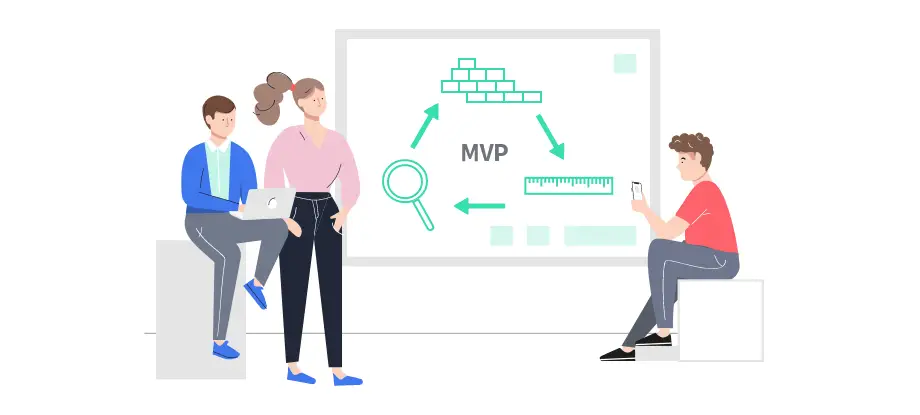The idea of a Minimum Viable Product (MVP) has gained popularity in today’s competitive and fast-paced corporate environment. The core elements that make a product or service work are the emphasis of an MVP, which is similar to a slimmed-down version of the item. All that matters is getting to the essential functions quickly.
This article aims to explore the benefits of MVPs, shed light on the factors affecting the MVP development cost, guide you in determining the essential features, help you mitigate development risks, and provide insights into the post-development phase.

The Concept of MVP
When it comes down to it, an MVP is essentially a stripped-down version of a product that highlights all of its key attributes. Before investing heavily in a major product launch, it’s all about experimenting, gathering feedback from users, and determining whether people genuinely want it. The appealing aspect of the MVP strategy is that it offers business owners and entrepreneurs the chance to gain real understanding and make wise decisions.
Its Benefits
The MVP development offers numerous advantages, including:
Faster time to market
Time is money in the modern rat race of business. The secret is to quickly create an MVP and release it to the market. By focusing on the essential features and capabilities, you may streamline the entire process and begin making money right away. This accelerated time to market gives you a competitive edge, allowing you to capture market share and establish your brand before others.
Cost-effective
Developing a full-scale product without validating its viability in the market can be a costly and risky endeavor. An MVP provides a cost-effective alternative by minimizing unnecessary expenses. Instead of investing heavily in building a fully fleshed-out product, you allocate resources to the most crucial features and functionalities. Before investing a lot of money in the product, you can test the market and get consumer feedback using this budget-conscious strategy.
User Validation and Feedback
Getting user feedback and having your assumptions confirmed are two of an MVP’s primary objectives. By releasing a simplified version of your product, you can get in touch with the industry leaders and ideal clients and learn what encourages interests and motivates them. The user insights are priceless because they help to design future iterations of your product and ensure that it is on point. By following these simple steps, you can quickly create a product that customers like and will gladly pay top dollar for, increasing their enjoyment and loyalty.
Mitigating risk
It can be risky to start developing a product before ensuring that the market is interested. The key to staying safe is creating an MVP. You can determine if users are interested in your product by putting it to the test in the market. You can also determine whether there is an enormous demand for it and identify potential problems. Receiving this early feedback enables you to make smart choices and change course when necessary, saving you from investing resources on a product that might not appeal to your target audience. You increase your chances of hitting the jackpot while minimizing the dangers by repeatedly making changes to your product in response to user feedback.
Factors Affecting the Cost of MVP Development

The cost of the MVP development might vary depending on a number of factors, including:
Complexity of the product: The more complex the product, the higher the MVP development costs.
Design and user interface: The level of design complexity and user interface requirements impact the development costs.
Integration and scalability: The need for integration with external systems or the potential for scalability can affect the overall MVP development cost.
Team size and expertise: The cost can vary based on the size of the development team and their level of expertise.
Determining Basic Features for MVP
When determining the basic features for your MVP, consider the following:
Core functionality: Identify the key features that make your product unique and valuable to users.
User experience: Prioritize features that enhance the user experience and provide value in the simplest possible way.
Market research: Conduct market research to understand the needs and preferences of your target audience, helping you identify the essential features to include in your MVP.
Mitigating MVP Development Risks
While developing an MVP, it’s crucial to be aware of potential risks and take steps to mitigate them:
Clear communication: With your development team, make sure everyone is on the same page and openly discussing goals and objectives.
Agile development approach: Adopt a flexible development strategy that enables you to build in stages, receive feedback frequently, and continue making improvements.
User testing: As you continue, sprinkle in some user testing to identify and address any problems or flaws with the usability and functionality.
Post-Development Phase
Your Minimum Viable Product (MVP) has been successfully developed. But the journey doesn’t end there. Now it’s time to take the necessary steps after the development phase to ensure your product’s long-term success. Here’s what you should do after the development:
Feedback analysis
Collecting and analyzing user feedback is crucial for the continued improvement of your product. Dive into the feedback you received during the MVP phase and identify recurring themes, pain points, and suggestions. Categorize the feedback based on its relevance and impact on the user experience. This analysis will provide valuable insights into the strengths and weaknesses of your product, enabling you to make informed decisions for future iterations.
Iterative improvements
It’s time to write down your strategy once you’ve analyzed the feedback and determined what requires a bit extra attention. Polish and buff that product of yours in a systematic way. Focus on the most annoying pain points and make them go away. Include novel features and capabilities that will appeal to your users. Keep in mind that even after the MVP development is finished, the game is not done. To remain successful and keep up with the always-shifting preferences of your audience, keep experimenting and pushing boundaries.
Market launch
Once you’ve incorporated the necessary improvements and enhancements, it’s time to plan your full-scale market launch. Develop a comprehensive marketing strategy that encompasses various channels, such as digital advertising, content marketing, social media, and public relations. Create compelling messaging that highlights the unique value proposition of your product and resonates with your target audience. Engage with influencers and thought leaders in your industry to build awareness and generate buzz around your product launch.
Conclusion
Joining the Minimum Viable Products (MVPs) bandwagon can significantly increase your chances of success in the competitive business world. You may reduce risks, save money, and make sure that your final product is what people want by focusing on the essentials, soliciting customer feedback, and continuously scaling up your product. So, what are you waiting for? It’s time to start thinking about an MVP and open the door to success right away!
Keep in mind that MVP development is similar to putting your toes in the water before taking the big leap. You can do market research, make final product adjustments, and launch your business.

 Bitcoin
Bitcoin  Ethereum
Ethereum  Tether
Tether  XRP
XRP  Solana
Solana  USDC
USDC  Dogecoin
Dogecoin  TRON
TRON  Cardano
Cardano